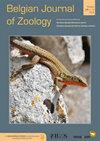一项关于Electra posidoniae Gautier的生态学研究,1954(Cheiloporta,Anasca),一种苔藓附生植物,仅在Posidonia oceanica(L.)Delile的海草上发现,1813
IF 1.1
4区 生物学
Q2 ZOOLOGY
引用次数: 3
摘要
苔藓虫Electra posidoniae Gautier仅在海王草Posidonia oceanica(L.)Delile的叶子上发现,在这种海草的叶表动物群中占主导地位。海洋被子植物(或海草)的表生植物通常在生态系统功能中发挥着重要作用,例如作为食物网的提供者。由于附生成分的功能障碍通常隐含在人类诱导的海草衰退中,因此了解原始地区该群落的动态和生活特征很重要。这项研究涉及通过测量雷夫拉塔湾(科西嘉岛,地中海)10米深处的平脊灰蝶的稳定同位素,每月评估其定殖动力学、生物量季节性和饮食组成。祖先(即殖民地的建立者)在接近冬季结束时出现,并且在沿着P.oceanica叶子的定居位置上非常有选择性。每平方米最多可记录100000个菌落。初春时,P.posidoniae的群落在附生群落生物量中占主导地位,但在6月被附生藻类所取代。粮食短缺可能与主导地位的下降有关。尽管C、N和S的稳定同位素比率表明,这种悬浮饲养者主要依靠水柱作为食物,但在晚春(即浮游植物开花后),其他食物来源,如重新悬浮的附生硅藻可能是重要的。此外,不能排除海草植物碎屑对该物种饮食的贡献。该物种在冬季几乎没有出现,这就提出了在春季招募的问题。本研究证实了该物种在海草草甸中的数量重要性,并探讨了其在水柱和海草生态系统之间关系中的作用。本文章由计算机程序翻译,如有差异,请以英文原文为准。
An ecological study of Electra posidoniae Gautier, 1954 (Cheilostomata, Anasca), a bryozoan epiphyte found solely on the seagrass Posidonia oceanica (L.) Delile, 1813
The bryozoan Electra posidoniae Gautier is found solely on the leaves of the Neptune grass Posidonia oceanica (L.) Delile, dominating the leaf epifauna of this seagrass. Epiphytes of marine angiosperms (or seagrasses) often play an important role in ecosystem functioning, for example as food web suppliers. As dysfunction of the epiphytic component is often implied in human-induced seagrass decline, it is important to understand the dynamics and life traits of this community in pristine areas. This study involved the monthly assessment of colonization dynamics, biomass seasonality, and diet composition through measurements of stable isotopes, in E. posidoniae at a depth of 10 m in the Revellata Bay (Corsica, Mediterranean Sea). Ancestrulae (i.e. colony founders) appeared towards the end of winter and were very selective in their settlement position along the leaves of P. oceanica . A maximum of 100,000 colonies per square meter was recorded. Colonies of E. posidoniae dominated the epiphytic community biomass in early spring, but were overtaken by epiphytic algae in June. Food shortage could be involved in this reduction in dominance. Although stable isotope ratios of C, N and S showed that this suspension feeder mainly relies on the water column for its food, other food sources such as re-suspended epiphytic diatoms could be important in late spring (i.e. after the phytoplanktonic bloom). Additionally, a contribution of seagrass phytodetritus to the diet of this species cannot be excluded. The species was almost absent in winter, raising the question of its recruitment in spring. This study confirms the quantitative importance of this species in the seagrass meadow and explores its role in the relationship between the water column and this seagrass ecosystem.
求助全文
通过发布文献求助,成功后即可免费获取论文全文。
去求助
来源期刊

Belgian Journal of Zoology
生物-动物学
CiteScore
1.90
自引率
0.00%
发文量
10
审稿时长
>12 weeks
期刊介绍:
The Belgian Journal of Zoology is an open access journal publishing high-quality research papers in English that are original, of broad interest and hypothesis-driven. Manuscripts on all aspects of zoology are considered, including anatomy, behaviour, developmental biology, ecology, evolution, genetics, genomics and physiology. Manuscripts on veterinary topics are outside of the journal’s scope. The Belgian Journal of Zoology also welcomes reviews, especially from complex or poorly understood research fields in zoology. The Belgian Journal of Zoology does no longer publish purely taxonomic papers. Surveys and reports on novel or invasive animal species for Belgium are considered only if sufficient new biological or biogeographic information is included.
 求助内容:
求助内容: 应助结果提醒方式:
应助结果提醒方式:


